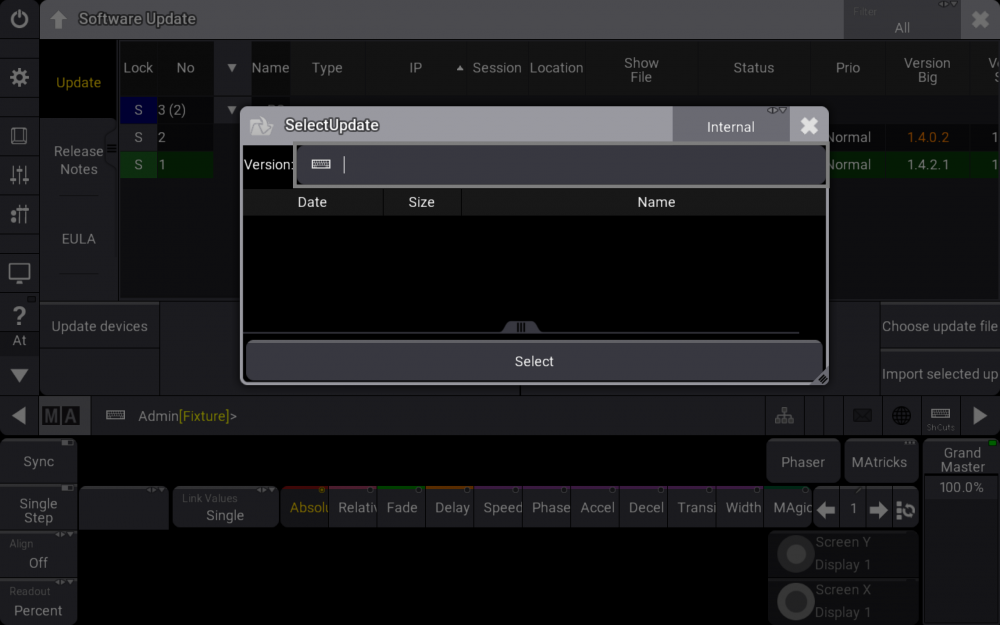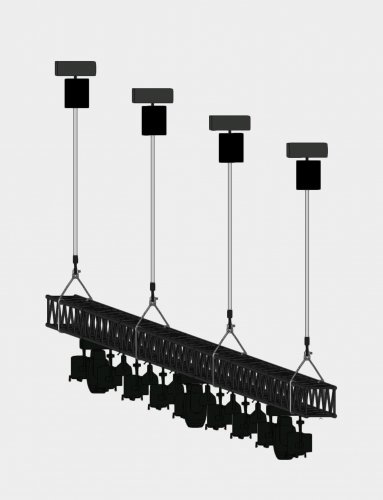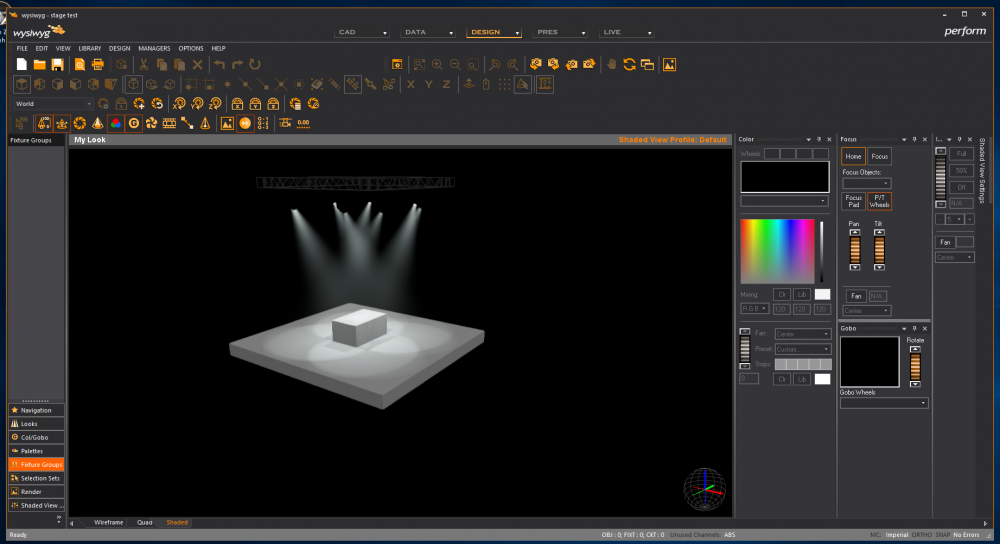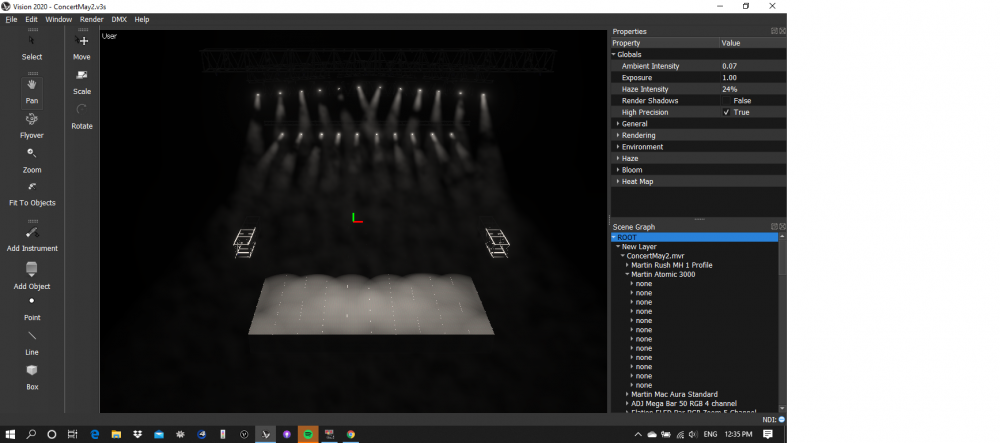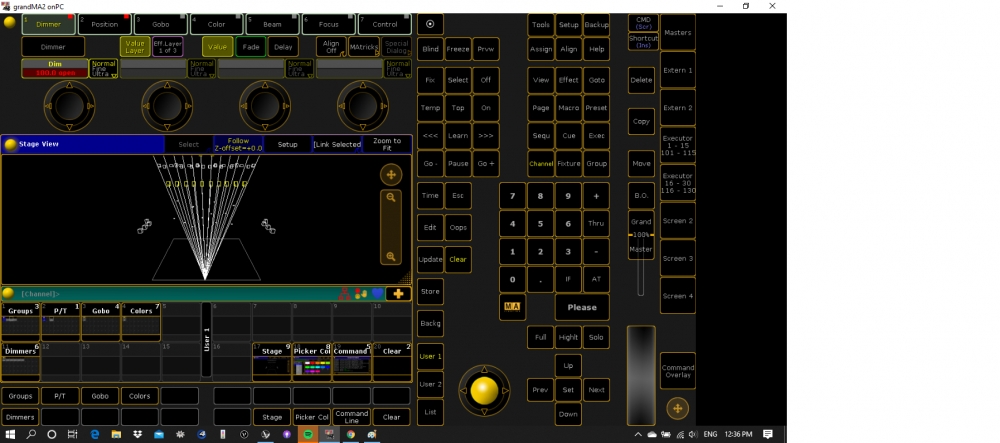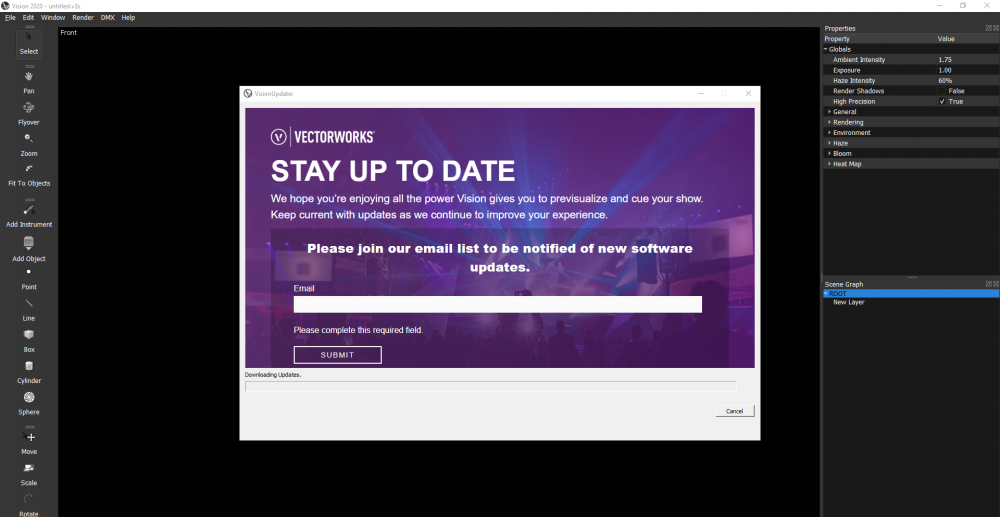Search the Community
Showing results for tags 'vision'.
-
Updated: 9/15/2022 What are the MINIMUM system requirements for Vision? On Windows: Windows 10 (64-bit), Windows 11, a 2.5 GHz processor, 4 GB of RAM, a 4GB video card, and a mouse with a middle button or scroll wheel. On Mac: macOS 12 (Monterey), macOS 11 (Big Sur), a 2.5 GHz processor, 4 GB of RAM, a 4GB video card, and a mouse with a middle button or scroll wheel. For both PC and MAC, it requires a dedicated graphics card supporting GL_ARB_draw_buffers extension. It is recommended to have 8 GB of VRAM, preferably 12 GB of VRAM or more. A graphics card released in the past three years (e.g., NVIDIA GeForce RTX 30 series, AMD Radeon RX 6000 series) is also highly recommended. We do not recommend any integrated Intel video chipset. While Vision may run, we do not support integrated graphics cards due to their lack of performance and speed. For the full list of system requirements and system recommendations, see Vectorworks System Requirements. Does Vision run macOS M-series? Yes, Vision runs on M-series machines. We recommend a M1 Pro or greater with a minimum of 32 GB Unified Memory. How many lights can I run in Vision? The speed of your video card and rendering settings directly impacts the number of lights that you can run. You can improve the performance of Vision by adjusting the Vision Preferences to better match the capabilities of your graphics card. This is most easily accomplished by adjusting the Performance-Quality slider in the Vision Preferences . If more control over the settings is desired, enter the Advanced portion of the Vision Preferences. From here, turning off Render shadows and Use haze texture; reducing the Texture Quality; rendering fixtures as black or turning off fixture rendering, and many other settings, can significantly increase the performance of Vision. If you are running a slower video card and are still experiencing sub-optimal framerates, you should consider upgrading to a faster video card. What is a dongle? Do I need one to run Vision? A dongle is a USB key that contains your license information, including the number of universes that you own and subscription data. Vision dongles are not compatible with macOS M-series computers. You do not need a dongle to run a Vision license. However, if you need to use grandMA2 with MA-Net2 as your DMX provider, MA Lighting requires the use of a dongle for Vision. The Vision dongle can be purchased directly from Vectorworks. Vision 2022 or higher: MA Lighting supports visualizer connectivity on the grandMA3 via MANet3 using the viz-key. The viz-key is available from purchase from your local MA distributor. How do I control Vision? Vision is listening for DMX-512. Any console or onPC/off-line editor that outputs Artnet, Hognet, MA-Net, MA-Net3, or sACN can be used to control Vision. MAC product integration is limited to Artnet, sACN, and MA-Net3 at this time. How many lights are in the Vision fixture library? While the numbers are continually changing, you can be assured that the fixtures from the major manufacturers are included. These include High End, Martin, Coemar, Vari*lite, ETC, and many others. What if I need a fixture that isn't included in the library? Vision customers are entitled to request a maximum of 4 lighting fixtures per 30 days, using the “SPOTLIGHT AND VISION FIXTURE REQUEST” form available on the support page of the customer portal. What exactly is Update Dongle, Update Library and Update Vision? The Update Dongle command contacts the Vectorworks server to update your dongle. It should only be necessary to run the Update Dongle command when you renew your Dongle Vision license. If you have an online activation license, there is no need to run this command. The Update Library command contacts a cloud-based internet server that all of our customers can access. When you access the Update Library server, it compares the latest library files against what you have on your computer and updates any files that have been added or changed.This ensures that you always have the most recent data available. We recommend that you run the Update Library command before you begin any major project. You must have an active Vision license to access the Update Library server. The Update Vision command contacts the Vectorworks server to update your Vision software to the latest available service pack. Do you have a trial version? Yes. Vision has a free downloadable 30-day trial which will allow you to run Vision. This will allow you to test Vision's capabilities and see the superior quality of Vision. You will find sample files, DMX recordings, and detailed information regarding patch, etc. in the "Demo Documents" folder within your Vision Trial installation. INSTALLATION Do I need any other programs to install Vision? All necessary support files are included in the Vision installer package. Should I plug my Vision dongle in before I start the install? We recommend installing using the provided serial number. For Vision 2023 the dongle is only necessary for using the MA-Net2 dmx provider. Can I change the installation directory? It is not recommended to manually change the installation directory of Vision. If you need to relocate Vision it is recommended that you uninstall the current version and run the Vision installer to install in a new directory. VISION How do I navigate in Vision? All navigation within Vision is accomplished using the middle mouse button. To pan up, down, or around, hold down the middle mouse button and move the mouse. To zoom in or out, hold Ctl+Alt and the middle mouse button and move the mouse in and out. To rotate the scene, press Alt and the middle mouse button and move the mouse. You can also use the tools that are provided in the tool window to zoom, rotate, pan, and tilt. Find a complete list in Vision online help. How do I focus conventional fixtures in my rig? Select the lights that you wish to adjust in the scene. All the lights are turned on. Another way to select the fixtures you want is to use the Once the lights are selected, you can move them all in sync by using the four arrow keys. These keys correspond to the pan and tilt of each fixture. If you wish to focus all selected lights to the same position, move your mouse to that position, right-click and select "Focus selected lights here." If you wish to focus each light individually, be sure to have the main window picked and hit the page down button which will highlight a single fixture. Focus that fixture using the arrow keys. When you complete, hit page down again and the next light is highlighted. Continue the process until all fixtures are focused. How do I adjust the haze in the scene? Haze can be adjusted in the Document Preferences window or by select the ROOT from the Scene Graph window. The movement of the haze is controlled by Haze Vertical Speed, Haze Horizontal Speed, Haze Depth Speed, and Haze Turbulence. By setting these to 0, the atmosphere will be constant without any movement. To set the amount of haze in the scene adjust the Haze Amount up or down, to suit your needs. A setting of 0 will assume no atmosphere (such as in a theater setting). If haze texturing is on, you can increase and decrease the density or cloudiness of the haze with the Haze Density setting. The performance and quality of haze renderings can be adjusted in the Vision Preferences window. This is most easily controlled with the Performance Quality slider. More detailed control of haze quality and performance can be unlocked in the Advanced section of this dialog. Haze Rendering Style, Haze Rendering Quality, and Use haze texture all impact the quality and performance of haze. Haze in its entirety can also be enabled or disabled at an application level with the Render haze checkbox. If I am running a complex scene, how can I increase speed? The easiest way to increase the speed of renderings is to adjust the Performance Quality slider in the Vision Preferences dialog box. By moving this slider towards Performance, quality will decrease but performance will increase. Try different slider settings to see what works best for the given scene. If you want more detailed control over performance and quality, the Advanced section of the Vision Preferences window may be helpful. You may consider eliminating the geometry associated with the lighting fixtures by setting Render Fixtures to Off in the Vision Preferences. You will notice that the fixture will disappear from the Vision, but the light is still emitting from where the fixture used to be. Significant speed increases can also be achieved by turning off Render shadows in the Vision Preferences . If your file contains multipart fixtures, checking the Force Emissive option for these fixtures will also improve performance. Lowering the Haze Rendering Quality or lowering the Haze Rendering Style may also improve performance. For files with a very large number of fixtures, disabling the High Precision option may increase performance with minimal impact on rendering quality. How do I connect my console to Vision? To begin, check out the forums on DMX Connectivity, which contains detailed instructions on connecting Vision to a number of the most popular consoles. In Vision, you only need to select the DMX Provider under the DMX menu. See the DMX Connectivity Articles for more details. What is the optimal resolution for running Vision? Once again, this is somewhat determined by your video card. Generally, you should run Vision at 1280x720. This will give you the optimum performance and quality for your real-time visualization. Vision is capable of running at much higher resolutions, but lower resolutions allow for better performance. Resolution is configurable from within the Vision Preferences and should be adjusted to best fit your needs based on the hardware being used. VISION UPDATES I have an expired Service Select membership; how do I get the latest build? Contact the sales team at sales@vectorworks.net and renew your Service Select membership. Vision Support will be able to reactivate your dongle remotely so that you can update the software to the latest version. My Service Select membership has expired. Can I still run Vision? Yes. Your version of Vision will still be available for you to use. However, you will no longer have access to the latest versions of Vision. To ensure that you have the latest and greatest versions of Vision at your fingertips, you’ll want to make sure that your Service Select membership stays current. Be aware that any fixtures released following your subscription date will not be visible in your Vision model.
-
Is it just me, or do others have the issue that Vision Licence has never been accessible via the customer portal/service select portal? Every year I have to contact the local distributor to send me my licence serial number for Vision. I still have the perpetual licence for both VW and Vision. Or is this just an Australia issue?
-
Hi Y'all... Pour yourself a coffee and tuck in; this is a long one! I'm having trouble mapping an NDI stream to various LED tiles placed on stage in set carts. The set looks like the following screenshot. All of the display surfaces are LED Screen plugin objects with dimensions and pixels set correctly in the OIP as indicated: The image on the LED screens is set in "Edit Array Image" where a custom texture is selected. Notice that the Scale is set to 50% to get the image to display correctly (the illusion is a stack of TVs with different images). The image used for the texture is only two TVs wide, so this makes sense as applied to the still image in VWX. Changing this scale, however, has no effect on the eventual video mapping problem that we shall see in Vision. I tried exporting MVRs with all of the Scale adjustments in this menu set to 100% and had the same results that are illustrated below. I also wonder what the "Capture Source Name" and "Capture Source Number" are in the "Select Vision Video Source" dialog. These names do not correspond to the names that Vision ends up asking for, and you could put Fred or Ethel in the "Capture Source Name" field and you never see those names come up again throughout the process: But let's not get distracted... OK, so now we move over to Vision, after exporting the LED tiles in their own MVR. The set carts that they travel in get exported as a separate MVR to keep things organized. These two MVRs plus my Amphitheatre MVR merge together in to this model: Let's begin by selecting our first LED array (in this case the 4 tile square array top center) and choosing Assign Video Input: We assign the video input a name: The video input is fed via NDI from a MacBook Pro running Resolume Arena. The NDI monitor on the Vision PC shows a smooth, steady video image in real time: We find the 1920x1080 NDI input that is being scaled by 1/3 to give us a raster of 640x360 for use in Vision. So let's crop the NDI stream! I scaled my 1080 template down to 640X360 in Photoshop to determine the exact corners of every crop and wrote them down (analog, in a notebook with a pencil) because the cropping tool in Vision is rudimentary at best. You can't zoom in on it, there's no grid or snap guide... best to use the tools in Photoshop and write down the pixels. So we get our square crop for our square video surface: And we do it for each of the LED screens in the model: During this process, plan to spend a lot of time looking at this screen, waiting for Vision to "see" the NDI input that it "saw" just perfectly moments ago: Eventually we have created 13 separate crops of the NDI raster and mapped them to our LED screens. And here is the confusing result: Note the different scaling of the crops! Nothing seems to work out right, except the SR High and SL High set carts! The 2wide x 4high carts are the only ones that display the crop faithfully. The Ctr Top crop is perfectly square, mapped to a perfectly square screen. It ends up stretched vertically. Ditto the Ctr Bottom... that one is stretched vertically and doubled. The math certianly does not work for the downstage 3wide x 1high boxes. Playing with the texture scaling and offset in Vision does not help... You can't fix an asymetrical scale as is occuring here. If we use Vectorworks to create an LED screen and send it to Vision, and Vision has the ability to crop an incoming NDI stream, why doesn't this just work? I did try sending the crops from Resolume as separate NDI streams but Vision could not see them as separate. Any help would be appreciated. Getting this model to work will greatly increase the chances that it will be useful to me before we get to rehearsals. Thanks peace aj peace aj
-
I would absolutely love it if Vision was integrated into Vectorworks. Making changes, updating patch, moving fixtures etc would be reflected in both the visualisation and CAD file and would all-round speed up the workflow.
-
- vision
- vectorworks
-
(and 1 more)
Tagged with:
-
Here's a weird one that I just want to document before looking further or coming up with a workaround: The Stage Right PA disappears... or has a partial "cloaking device"! This is a screenshot in real time: And here's a rendered still generated from this exact scene: What's happening here? I suspect maybe the PA symbols were mirrored when inserted in to the VWX model, so I'll start there. But right now there's a black hole that swallows these objects on rendering. Notice that the bottom cabinets on the SR PA are visible, and it's not all black; the fixtures on the truss behind are quite visible. I suspect Romulan technology, stolen by the Klingons... but i'm not enough of a Trekkie to take that metaphor any further... Any thoughts? aj
-
Hello to all. I started to learn Vision 2021. I downloaded vision and Grand Ma3 onPC. However ı got some problems. I applied every directions step by step as @JuanP said ( However I couldn't update release_wiz_key_1.4.53.8.xml. because it doesn't appear any xml files. (upload the photo). Is it about ma3 onPC? I can't change the updatemode version. I think updatemode and idlemaster should be same version. (photo 2) And also i have to inform you something. I have no dongle and i have no Gma3 onPC port node. Can't i work without them? Can you please help me about this matter? Best Regards. 🙂
- 4 replies
-
- grandma3
- connection
-
(and 3 more)
Tagged with:
-
Hi all! In VW2021 I've made a model of a venue and a light plot containing trusses, hoists, lighting devices and so on. I then exported the venue (no trusses, lights, hoists) as a ESC file and imported it to Vision. So far so good (I think). Next, I exported the trusses, hoists, lighting devices and everything else used in the set design as a MVR file. Most of the things look ok, but why, oh why, does Vision import (or Vectorwork export) it like this? File with white background is from VW2021, before exporting. As you see, hoists are up side down and no truss is visible. But still the chains are at the correct position. And yes, all classes are visible during export 😃 I asked this question on FB as well but no answer so far. Thanks all! Looking forward! Martin
- 11 replies
-
- vision
- vision2021
-
(and 1 more)
Tagged with:
-
vision Vision needs a Virtual Software Console
VClaiborne posted a question in Wishlist - Feature and Content Requests
How many Vision users out there think Vision needs to include a Virtual Software Console that gives you the ability to control fixtures inside of Vision without a lighting console??? Click Like if you agree! Shown Below: WYSIWYG Realizzer Light Converse -
Higher education graduates are eligible for a 40 percent discount on award-winning design software licenses up to twelve months after graduation To help graduating students transition into their professional careers, global design and BIM software provider, Vectorworks, Inc. is offering recent graduates 40 percent off perpetual licenses as part of its student2PRO program. This deal is applicable to any Vectorworks product. “Starting a career after graduation is a momentous milestone for any graduate, and the student2PRO program is the perfect initiative in helping graduates take that first step toward career success without having a huge financial burden setting them back,” said Alice Lowy Marketing Programs Director. “This option is to help ensure up-and-coming professionals have the necessary 2D drawing, 3D modeling, and BIM tools to bring their designs to life.” student2PRO is a gateway program helping recent graduates jumpstart their professional careers more easily by offering discounts on the standard price. Additionally, those who take advantage of student2PRO are eligible for a 40 percent discounted membership to Vectorworks Service Select — the maintenance program that includes upgrades to product, priority technical support, exclusive training opportunities and early release of new content libraries. Service Select members also receive member-only features in Vectorworks Cloud Services. “Going the student2PRO route was such a valuable option for me and now as a full-time lighting designer, I use the features in Vision and Spotlight in my day-to-day work on theatre productions,” said Chloe Clark, a San Diego State University alumna. “Not only is the program an economical option for graduating students, but it’s also beneficial that Vectorworks updates and enhances its software regularly in conjunction with my industry constantly changing. It’s an easy way for me to always stay up to date.” To qualify for student2PRO, graduates must have completed a degree at a university, college, post-secondary vocational or poly-technical school within the past 365 days and submit transcripts or a diploma showing degree completion and graduation date. Alternatively, graduates can take advantage of the current monthly or yearly subscription license offerings on Vectorworks products, where available. For more information or to submit your transcripts or diploma, visit vectorworks.net/education/student2pro.
-
- 1
-

-
- alice lowy
- student2pro
-
(and 3 more)
Tagged with:
-
Regards. I have this difference in panning between vision and ma2 and ma2 3d. I exported from Vectorworks to Vision .MVR I used the MA2 plug-in to export the vectorworks patch to MA2. Any ideas how I could be sure which of the two is correct in real life? From already thank you very much. Take care and keep SAFE !!!
-
Hey All, Very new to the entire world of vision. I am using the ETC EOS console to control my vision file. I have the Martin Rush Par 2 RGBW Zoom 5 channel fixture in the file When choosing colors in EOS (by Gel color) some are close but most are way off. Is this normal? I used the GDTF fixture mode from the GDTF web site. Any help would be appreciated Thanks, Jeff Miller Attached is the view of L139 mixed in the fixtures (Don't think so) Also attached is the EOS console breakdown of the color
-
Greetings. I am having the following problem and wanted to see if I am doing something wrong. The situation is as follows, I am using some ETC source 4 and in vw I make the shutter cuts. In the VW render they look good. When I use Vision, directly exported they only 2light turn on and 1 only shows the cut, but not the color. If I export it as MVR, they all light on, but cuts and colors don't appear. Any idea? Happy weekend !!! (Safe in home)
-
hi to everyone! anyone of you has problems updating library in vision? When I press "update library", the screen stays on "downoading update" for hours and doesn't download anything. See attached image. Thanks for your support!
-
Hey All, MAC user here During this Covid-19 hell I want to learn how to program a Hog Console unless the Grand MA is a better choice. (y'all tell me) I have a MAC book pro i want to run bootcamp on to use the HOG pc or Grand MA software. I will use my Mac pro to run Vision. I know i have to buy windows 10 (any ideas for reliable trustworthy versions) BUT what else am i going to have to buy. (software, dongles, etc) I would like to have a few (maybe 1 to 3) DMX universes. This is strictly going to be used in vision only as a learning tool. If i ever get near real lights i will also get near a real hog to dump the show into. Thanks for the info in advance Jeff Miller
-
Hello everyone I am working on a show, where we want to pre visualise a lot of stage element movements. They go on every axes, and rotate. My problem is, the rotation. Is it possible to change the anchor point of a object in Vision? It seems as it takes the 0;0;0 coordinate as default anchor point as default. Best from Mathias
- 6 replies
-
- vision
- anchor point
-
(and 2 more)
Tagged with:
-
Students and professors can now request our free educational Vision software by filling out our educational Vision request form. https://www.vectorworks.net/en-US/education?showModal=academic-lab-request For schools, professors and IT people can request lab donations of our educational Designer software now with the option to add on educational Vision, educational ConnectCAD, and educational Braceworks via our lab donation request form. https://www.vectorworks.net/en-US/education?showModal=academic-lab-request Student/professor licenses of Braceworks and ConnectCAD are not yet available at this time. Feel free to reach out if you have any questions, you can email me at mdier@vectorworks.net.
-
- educational
- vision
-
(and 2 more)
Tagged with:
-
Scholarships awarded to 30 students for 20 winning projects in 2019 Vectorworks Design Scholarship Columbia, MD (October 16, 2019)—Global design and BIM software provider Vectorworks, Inc. continues to support the next generation of designers, naming Kristopher Clemson winner of the 2019 Richard Diehl Award, the grand prize for the Vectorworks Design Scholarship. With over 1,600 submissions, scholarships were awarded to 20 student projects from the architecture, entertainment, landscape and interior design industries. Winners included both individual and group submissions. The winning project, “The Octagon,” submitted by Clemson, a recent graduate of Full Sail University and founder of Bifröst Lighting LLC, focuses on lighting design, Vision and MA 3D renderings. Clemson used Vision alongside Vectorworks Spotlight to help with previsualization and implementing MA lighting on a PC. “It is an incredible honor to receive this scholarship and to be the first entertainment winner of the Richard Diehl Award,” said Clemson. “As my first time applying to the Vectorworks Design Scholarship, I wasn’t sure what to expect. I struggled with the design process, but the usability, flexibility and overall presentation was achievable with Vectorworks software. I advise anyone looking to apply next year to suffer for your art and to ensure you have a well-balanced life of creativity surrounding yourself with creative mentors and friends.” In addition to the Richard Diehl Award winner, we congratulate the regional scholarship winners selected by an international panel of design, academic and media professionals. Submissions were evaluated based on design integrity, originality, the effective use of computer technology and communication of design vision. Here are the winning projects: ARCHITECTURE WINNERS: · “Caretaker’s House” by Tom Hudson-Davies, Aarhus School of Architecture (Arkitektskolen Aarhus) · “Collage City” by Alex Wong and Ningxin Huang, Columbia University · “Cultura Gastronomy Centre” by Jeremy Shigemitsu, British Columbia Institute of Technology · “Haus der Begegnung Halberstadt” by Julia Fehling, Technical University of Braunschweig (Technische Universität Braunschweig) · “Listotektura” by Marina Georgieva, Birmingham City University · “Microcosmes: Sublimation Des Paysages Inconscients” by Pauline Soulenq, Charlotte Batifoulier, Matthieu Faria and Elisabeth Sala, National School of Architecture of Clermont-Ferrand (Ecole Nationale Supérieure d'Architecture de Clermont-Ferrand) · “PROTOCELL_00” by Monika Kalinowska and Denys Karandiuk, University of Applied Arts Vienna (Universität für angewandte Kunst Wien) · “Wasserschloss” by Geraldine Recker and Saida Brückner, Swiss Federal Institute of Technology Zurich (Eidgenössische Technische Hochschule Zürich) · “Wooden Crown” by Mickael Minghetti and Karol Wojtas, Delft University of Technology (Technische Universiteit Delft) INTERIOR DESIGN WINNERS: · “Indoor Community Park: De Potterij” by Robin van Vemde, Thomas More Mechelen · “Pawilon Plansza” by Weronika Kempińska and Marta Kluba, Academy of Fine Arts Władysław Strzemiński in Łódź (Akademia Sztuk Pięknych im. Władysława Strzemińskiego w Łodzi) · “Raum für Abschied” by Claudia Hynek, Darmstadt College (Hochschule Darmstadt) LANDSCAPE WINNERS: · “Amphibian Orinoquia” by Ekaterina Trosman and Christian Cueva, University of Pennsylvania · “Dreiklang Landschaft” by Jonathan Sironi and Marie-Luise Tschirner, Technical University Dresden (Technische Universität Dresden) · “IMBROS: Marine Experience and Gastro Tourism” by Zeynep Gulsah Aygun, Istanbul Technical University (İstanbul Teknik Üniversitesi) · “Kalmthout Centraal: Trap de Heide in Gang!” by Brent van den Bossche, University of Antwerp (Universiteit Antwerpen) · “Les Toits d’Ardoines” by Zacharie Malan, University of Lorraine (Université de Lorraine) · “Rewitalizacja Obszaru Przed Dworcem Nadoddrze We Wrocławiu” by Kinga Sadowska, University of Life Sciences in Wroclaw (Uniwersytet Przyrodniczy we Wrocławiu) ENTERTAINMENT WINNERS: · “Pyura: The 333 Tour” by Mauro Pujia, Polytechnic University of Madrid (Universidad Politécnica de Madrid) “We congratulate all winners of this year’s Vectorworks Design Scholarship, and we hope these scholarships play a fundamental role in their education,” said Vectorworks Marketing Programs Director Alice Lowy. “Each year, we receive more submissions and are always impressed with the quality of work the next generation of designers come up with.” In addition to the monetary awards, winners received free Vectorworks educational software licenses for their schools and complimentary training for faculty and students. Visit the Vectorworks Design Scholarship web gallery to view the winning designs and runner-up projects. Interested students may sign up for notifications regarding future scholarship awards. About Vectorworks, Inc. Vectorworks, Inc. is an award-winning design and BIM software provider serving the architecture, landscape architecture and entertainment industries in 85 countries. Creating intuitive software since 1985, we’ve become the preeminent software built to manage the entire design process. Globally more than 685,000 users are creating, connecting and influencing the next generation of design with Vectorworks on Mac and Windows. Headquartered in Columbia, Maryland, with offices in Atlanta, Georgia, Newbury and London, England and Vancouver, Canada, Vectorworks is a part of the Nemetschek Group. Learn how we empower designers to create experiences that transform the world at vectorworks.net or follow @Vectorworks. ###
-
- 1
-

-
- vectorworks spotlight
- vision
- (and 3 more)
-
Entertainment Industry Specialist Vectorworks Inc. is a global software product company targeting entertainment, architecture and landscape industries with enterprising and intuitive solutions that allow users to create unique designs and 3D visualizations. We are looking for an Entertainment Product Specialist that will be responsible for establishing rapport with potential and actual customers as well as other industry influencers. The goal of this position is to provide consultation, industry expertise, and training services for customers, prospects, and our internal teams. What’s in it for you? The Entertainment Product Specialist will liaise regularly with members of our sales and marketing teams, the R&D department, as well as senior company managers. You will interact daily with entertainment industry professionals and impact the future of 3D modeling CAD software. Work with the Vectorworks product suite on a range of projects in a collaborative team environment. Our company encourages work life balance and idea generation as we continue to leverage technology to advance our products for our users’ needs. In this role, you should expect to: Maintain an advanced understanding of the Vectorworks products and competitors in the Lighting, Scenic, AV, and Event industries. Discover and act upon speaking, sponsorship, and networking opportunities with industry organizations, trade shows, and academic institutions. Create and deliver marketing presentations and product demonstrations for users and prospects at various user group meetings, trade shows, and other events. Cultivate and provide customized online and one-on-one training and detailed product demonstrations for prospects. Work closely with the sales and customer success teams to understand the customer’s needs, desires, and complaints. Identify and supporting business development opportunities. Contribute to internal staff and channel education about the entertainment industry. Other duties as assigned. Why do you want this job? Because you are: A designer looking for the opportunity to do something more with your subject matter expertise A technologist with a passion for how software can impact the entertainment industry. Naturally training or teaching others how to leverage tools and workflows to improve their design goals. Why do we want you? Because you have: A Bachelor’s of Fine Arts Degree or equivalent work experience. 4+ years related work experience. Experience working in a company environment on live events and performances. (strongly desired) High proficiency in CAD and Pre-viz software. Vectorworks Spotlight and Vision preferred. Strong organizational skills for thorough planning and project execution. Comfort with speaking to large audiences. Ability to show initiative, multi-task, prioritize, and meet deadlines. A positive attitude and willingness to work with the team to achieve departmental goals. Vectorworks Inc. is an Equal Opportunity/Affirmative Action Employer Please email recruiting@vectorworks.net if you have any questions about this position!
-
I've used DMX transform for quite some time, only to move thing up and down, besides dealing with inches to figure out heights works great.. Today I wanted to rake a truss con "variable speed hoist" and found out the now (I believe this was not the case of old and beloved Vision 2.3) everything rotates around the local origin, this is also stated in the manual. Is there any workaround to get thing to rotate on the object axis? If not, I cannot figure out one good reason to rotate anything around the local origin in the entertainment world... Please someone explain what the benefit would be.... EDIT: I did find a workaround, if you place the whole object you want to move centered to the local origin in VW, it will rotate on its center. The only problem with that is that you have to move everything again in Vision in inches.... I really do hope I'm missing something here...
-
Beforehand I think this is great and something we've asked for some time, so Thanks! On the other hand, I haven't found any information that specially shows how it works so here are some questions: - I am guessing that the "Channel" field has to be the Unit number, can this be changed? - I've tried to use the numbering tool to get the DMX address populated but haven't found it, is the patch window the only way to get it done? If so, this is something to reconsider... - I've seen the Vision data mapping has vanished and for what I've tried it uses the same fields as the patch window, is this correct? Is this editable?
-
I'm involved with a project right now previz'ing with Vision 2019 (Windows 10) and GrandMA2 onPC. They are talking to each other via MAnet protocol. I have not yet had an opportunity to test Vision 2019 with a real desk. Will Vision 2019 listen to MAnet from MA Hardware (Full-Size, Light, etc.), or should I be prepared to output Art-Net or sACN? Thanks!
-
Hello I am a newbie to Vision only a few days into it. I already have a large show that requires me to have a media inputs to the pre-vis. I don't see to much info on this but i was told Vision can support it. So question 1, how do you config the screens / led walls 2, how to get input to Vision via my media server. Can it be via CITP. Also after reading some of the posts regarding the video inputs to vision i hope it gets fixed really quick or i also have just spent a lot of $$ for not able to Pre-Vis a major part of programming shows.
-
Hi ! Today I loose 12 Hours to connect Grand Ma3 ( run grandMA2 Os) to vision , without results . My question is : Is there a guide to make this ? My configuration : MA3 (grand MA 2 OS ) conected al my workstation trought a Zyxtel Switch (1Gb/s) . Ip adress of my NetworkCard : 192.168.0.220 . ip on Ma > 192.168.0.25 I changed more times all ip's. I installed 3 Time Vision 2019 Sp1 . Note: grandMA on PC connect succesfull to grandMA3 , withowt problems . Any solution
- 10 replies
-

GDTF importer to create Vision Symbols
allannathan posted a question in Wishlist - Feature and Content Requests
GDTF importer for Vision Symbols... maybe the physical form can be based on the 3D info from the Vectorworks file and the attributes can be defined by GDTF? -
Hello All So once again struggling to find any useful information in the tiny manual. Very simply need to display video content from a video file on my computer on a screen inside vision. Had a more complex file but started from a black vectorworks document to test. I have made a surface inside Vectorworks, selected the vision video source and then save and sent to vision. Inside vision the screen flashes once and then is blank. What size can the video file be resolution wise. What format should the video file be. How do you crop the video to fit the screen. I know you can crop if there is a capture source but no option seems to exist for saved videos. Please any help much appreciated. Richard





















